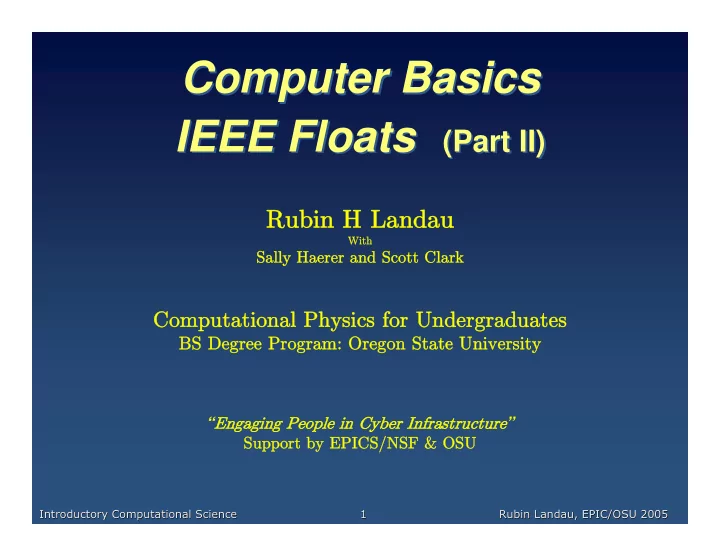

Computer Basics Computer Basics IEEE Floats IEEE Floats (Part II) (Part II) Rubin H Landau Rubin H Landau With With Sally Haerer and Scott Clark Sally Haerer and Scott Clark Computational Physics for Undergraduates Computational Physics for Undergraduates BS Degree Program: Oregon State University BS Degree Program: Oregon State University “ Engaging People in Cyber Infrastructure Engaging People in Cyber Infrastructure ” Suppor Support by EPICS/NSF & OSU by EPICS/NSF & OSU Introductory Computational Science 1 Rubin Landau, EPIC/OSU 2005 Introductory Computational Science 1 Rubin Landau, EPIC/OSU 2005
Model: Machine Precision Model: Machine Precision Model: Machine Precision Floating point limited precision − singles (32b): 6-7 decimal places − doubles 15-16 places − affects calculations: 7 + 10 -7 = ? 7 = 0 1000 0010 1110 0000 0000 0000 0000 000, 10 -7 = 0 0110 0000 1101 0110 1011 1111 1001 010 Different exponents can't add mantissas Shift bits (insert 0's) till same exponent 10 -7 = 0 1000 0010 0000 0000 0000 0000 0000 000 7 + 10 -7 = 7 − Last digits lost (truncation error) − Ignore 10 -7 in single precision Introductory Computational Science 2 Rubin Landau, EPIC/OSU 2005 Introductory Computational Science 2 Rubin Landau, EPIC/OSU 2005
’’ m ``Machine Precision’’ m ``Machine Precision’’ ``Machine Precision m • Measure of precision in computation • Definition: max # add to 1 gives 1 as answer 1 c + m = 1 c (1) • x stored on computer: m 10 -7 (single), m 10 - 16 (double) (2) x c x (1 ) , | | m (3) • Scientists: Just say No! to singles Introductory Computational Science 3 Rubin Landau, EPIC/OSU 2005 Introductory Computational Science 3 Rubin Landau, EPIC/OSU 2005
Time for Exercises Time for Exercises Time for Exercises in Lab in Lab in Lab Introductory Computational Science 4 Rubin Landau, EPIC/OSU 2005 Introductory Computational Science 4 Rubin Landau, EPIC/OSU 2005
Landau’ ’s Rules of Education s Rules of Education Landau Landau’s Rules of Education Most of ed is learning names; ideas 1. simple Confusion is the first step towards 2. understanding Traumatic experiences are good 3. teachers Introductory Computational Science 5 Rubin Landau, EPIC/OSU 2005 Introductory Computational Science 5 Rubin Landau, EPIC/OSU 2005
m Exercise: Determine Your Exercise: Determine Your m Exercise: Determine Your m 1. Determine the machine precision m m of your computer Sam ple pseudocode: eps = 1. begin do N times eps = eps/2. // Make smaller one = 1. + eps write: loop number, one, eps end do 2. Determine m m for single & double precision (floats) 3. * Determine precise values (decimal OK, octal, hexadecimal/octal better) Introductory Computational Science Rubin Landau, EPIC/OSU 2005 Introductory Computational Science Rubin Landau, EPIC/OSU 2005 Lab 1
Exercise: Summing Series Exercise: Summing Series Exercise: Summing Series e − x ' 1 − x + x 2 2! − x 3 · · · + x N 3! + · · · + remainder (sum =) 2! 3! N ! (term) 1. Calculate e – x : x = 0.1, 1, 10, 100 , 1000 2. Require “absolute” error less than 1 part in 10 8 | term/ sum| < 10 -8 remainder ≈ term Presumptions: no roundoff error Introductory Computational Science Rubin Landau, EPIC/OSU 2005 Introductory Computational Science Rubin Landau, EPIC/OSU 2005 Lab 2
Series Exercise (cont) Series Exercise (cont) Series Exercise (cont) e − x ' 1 − x + x 2 2! − x 3 3! + · · · + x N (sum =) N ! (term) term = 1, sum = 1, eps = 10**(-8) // Initialize do term = -term * x/i // “Good”, factorials “bad” sum = sum + term // Add in term while abs(term/sum) > eps // Continue if error end do 3. Output as table x N sum |sum - exp(-x)| /sum “ exp(- x )” = built-in exponential ( Math.exp ) 4. Compare “good'' to “bad'' (factorials and powers) Introductory Computational Science Rubin Landau, EPIC/OSU 2005 Introductory Computational Science Rubin Landau, EPIC/OSU 2005 Lab 3
Recommend
More recommend